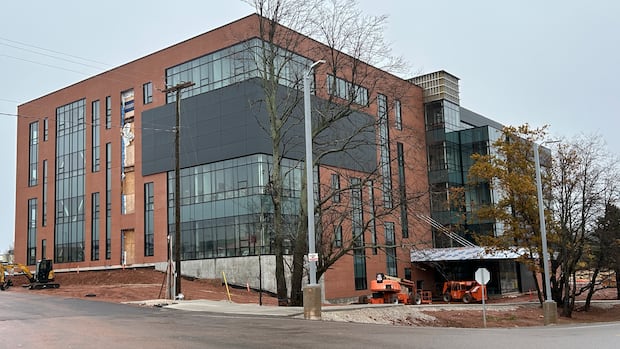Science
UPEI Launches Innovative Medical Simulation Centre for Training

The University of Prince Edward Island (UPEI) has officially opened its new Clinical Learning and Simulation Centre (CLSC), providing medical students with advanced training tools designed to enhance their clinical skills. This innovative facility includes high-fidelity manikins and realistic simulation environments, enabling students to engage in practical learning before interacting with actual patients.
Catherine O’Brien, a well-known actor and director from Prince Edward Island, is part of the team at the new centre. She previously worked with the University of Toronto, where she participated in a program that utilized actors as standardized patients in medical training. In her current role at UPEI, O’Brien helps students practice essential skills, such as patient interviews and empathetic communication.
“The aim is to create a safe environment for students,” O’Brien explained during a recent broadcast on CBC. “They can focus on learning how to make patients feel comfortable while responding to their questions and symptoms in a realistic setting.”
Realistic Training for Future Healthcare Professionals
The CLSC aligns closely with UPEI’s mission to prepare students for the demands of the healthcare sector. Paul Charles, the centre’s simulation program manager, emphasized the importance of providing realistic training scenarios. The facility replicates clinical settings, including hospital rooms equipped with medication carts and vital signs monitors.
“Using high-fidelity manikins that can breathe, talk, and even simulate medical emergencies, we bridge the gap between classroom education and real-world experience,” Charles stated. “This approach enhances student competence and confidence, ultimately improving patient outcomes and easing the burden on the healthcare system.”
The centre’s resources are not limited to students; healthcare professionals can also utilize these tools for ongoing skill development. Tammie Muise, the CLSC director, noted a recent addition to their training capabilities: a “simulation rig” designed to mimic an ambulance environment.
“This mobile unit allows us to simulate critical scenarios, such as responding to a stroke or heart attack,” Muise explained. “Training in this context is vital, as time is often crucial in emergency situations.”
Bridging the Gap Between Theory and Practice
O’Brien has already had the opportunity to interact with the inaugural cohort of medical students during their orientation. She expressed enthusiasm about working with them in future training sessions, highlighting the significance of hands-on experience in medical education.
“I’m looking forward to helping the students develop their skills in upcoming sessions,” O’Brien remarked. “The practical application of their learning is essential for their future careers in healthcare.”
UPEI’s CLSC represents a significant investment in medical education, creating a foundation for the next generation of healthcare professionals to thrive in their careers. The unique combination of technology and real-world role-play prepares students to face the challenges of the medical field with confidence and competence, ultimately benefiting patient care in the community.
-

 Science2 months ago
Science2 months agoToyoake City Proposes Daily Two-Hour Smartphone Use Limit
-

 Health2 months ago
Health2 months agoB.C. Review Reveals Urgent Need for Rare-Disease Drug Reforms
-

 Top Stories2 months ago
Top Stories2 months agoPedestrian Fatally Injured in Esquimalt Collision on August 14
-

 Technology2 months ago
Technology2 months agoDark Adventure Game “Bye Sweet Carole” Set for October Release
-

 World2 months ago
World2 months agoJimmy Lai’s Defense Challenges Charges Under National Security Law
-

 Technology2 months ago
Technology2 months agoKonami Revives Iconic Metal Gear Solid Delta Ahead of Release
-

 Technology2 months ago
Technology2 months agoSnapmaker U1 Color 3D Printer Redefines Speed and Sustainability
-

 Technology2 months ago
Technology2 months agoAION Folding Knife: Redefining EDC Design with Premium Materials
-

 Technology2 months ago
Technology2 months agoSolve Today’s Wordle Challenge: Hints and Answer for August 19
-

 Business2 months ago
Business2 months agoGordon Murray Automotive Unveils S1 LM and Le Mans GTR at Monterey
-

 Lifestyle2 months ago
Lifestyle2 months agoVictoria’s Pop-Up Shop Shines Light on B.C.’s Wolf Cull
-

 Technology2 months ago
Technology2 months agoApple Expands Self-Service Repair Program to Canada









